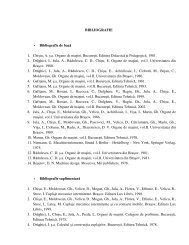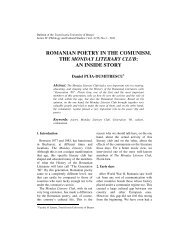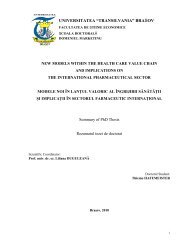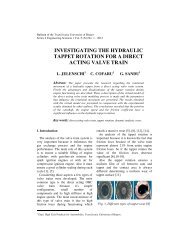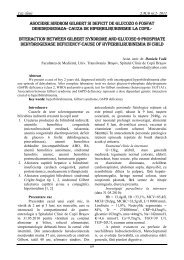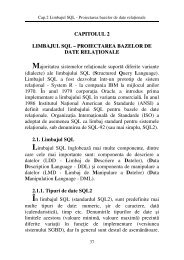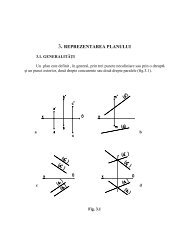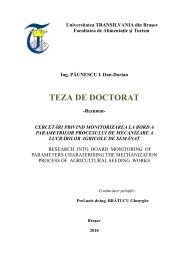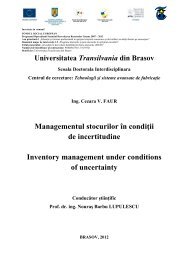TRACING ZERLINA'S ANCESTORS
TRACING ZERLINA'S ANCESTORS
TRACING ZERLINA'S ANCESTORS
Create successful ePaper yourself
Turn your PDF publications into a flip-book with our unique Google optimized e-Paper software.
M. BUHAICIUC: Tracing Zerlina’s Ancestors 79<br />
which Tisbea cares in De Molina, in<br />
Andrea Cicognini’s play, Rosalba does not<br />
resembles Tisbea’s personality, being<br />
portrayed as a weak figure in the play.<br />
5. Carlo Goldoni’s Elisa<br />
Another Italian version of Don Giovanni<br />
written one hundred years later, in 1736, is<br />
Carlo Goldoni’s Don Giovanni Tenorio or<br />
The Dissolute Man. The action of the play<br />
takes place in Castile and in the<br />
surrounding countryside. The noble<br />
characters are similar in features with those<br />
from earlier plays, except Elisa, a Castilian<br />
shepherdess and Carino, her lover. In<br />
Goldoni’s play, Elisa is as complex, strong<br />
and interesting as Tisbea is in De Molina’s<br />
El Burlador de Sevilla y convidado de<br />
piedra.<br />
Elisa appears on stage in the second act<br />
with her lover Carino. They swear each<br />
other fidelity for life. In the next moment,<br />
when left alone on stage, Elisa encounters<br />
Don Giovanni. Her mind and heart are<br />
changed once again. If Tisbea was more<br />
reserved in her manners, yet sincere, Elisa<br />
is a betrayer. Her purpose is to only enjoy<br />
herself and obtain a better social position.<br />
She pretends to love anyone who would<br />
offer her a better status. Elisa even begs<br />
Don Giovanni to marry her as soon as<br />
possible with the excuse that tomorrow she<br />
might have another offer.<br />
In comparison with Tisbea’s attempt to<br />
commit suicide, Elisa’s simulation of<br />
dying is only a trick to keep her lovers<br />
around.<br />
6. Gazzaniga-Bertati’s Maturina<br />
With eight months before Mozart’s Don<br />
Giovanni was performed, Giusseppe<br />
Gazzaniga presents in 1787, in Venice Il<br />
Capricio Dramatica, an opera in two acts.<br />
The first act is a prolog to Don Giovanni, o<br />
sia il convitato do pietra, which itself is a<br />
drama giocoso in one act. Bertati’s libretto<br />
is very close to Da Ponte’s. Zerlina’s and<br />
Masetto’s correspondents are Maturina and<br />
Biagio. The two young peasants are having<br />
their wedding, to which Don Giovanni<br />
shows up. Attracted by his charm, his<br />
words and convinced by his promise to<br />
marry her, Maturina accepts Don Giovanni<br />
in her house. What she is not aware of yet<br />
is that this Don is aggressive, even more<br />
than Da Ponte’s Giovanni. In this play,<br />
Don Giovanni slaps and beats Biagio in<br />
front of Maturina’s eyes. Even after Biagio<br />
is beaten, Maturina considers Don<br />
Giovanni a potential husband, who might<br />
offer her a change in her life. Unlike<br />
Tisbea and Elisa, Maturina is not as direct<br />
in her thought and feeling deliverance. She<br />
does not communicate directly to her stage<br />
partners. We understand her feelings from<br />
her actions. The contradictions in her<br />
character are not well defined. Hermann<br />
Albert makes a remark in his book<br />
Mozart’s Don Giovanni regarding the<br />
singers of Maturina and Biagio in<br />
Giusseppe Gazzaniga’s opera, Il Capricio<br />
Dramatica. The soprano, who plays<br />
Maturina’s role, also sings Donna Anna;<br />
and Biagio’s interpreter also performs the<br />
Commander’s part in the same<br />
performance. Maturina never meets Donna<br />
Anna in this opera.<br />
7. Molière’s Charlotte<br />
Molière’s Don Juan ou le Festin de<br />
Pierre was written in 1665, only thirty-five<br />
years after Tirso de Molina’s El Burlador<br />
de Sevilla y convidado de piedra.<br />
Molière’s play was not based directly on<br />
De Molina’s work. In fact, I have found<br />
the two plays very different. Molière’s<br />
Don Juan is more sophisticated. He<br />
represents a “thoughtful” - seducer rather<br />
than a man of action. Molière has<br />
embodied in his protagonist the type of the<br />
libertine and the religious skeptic, who




